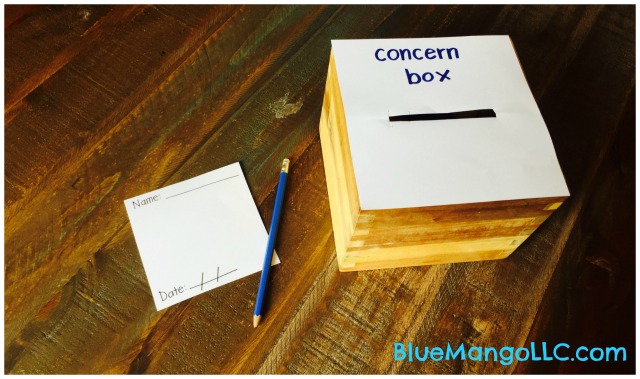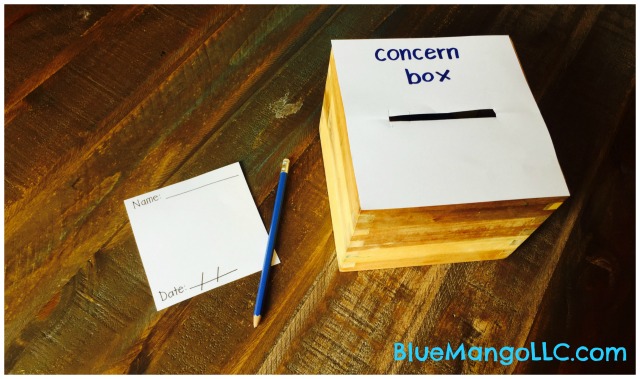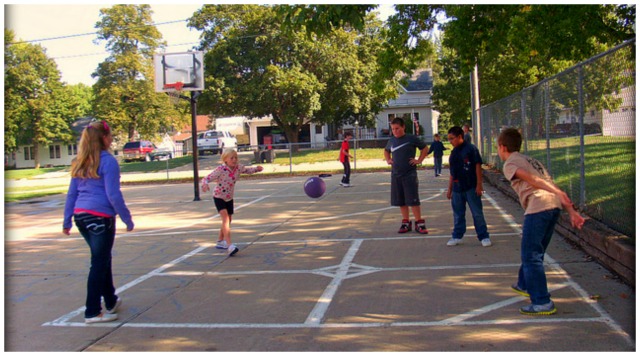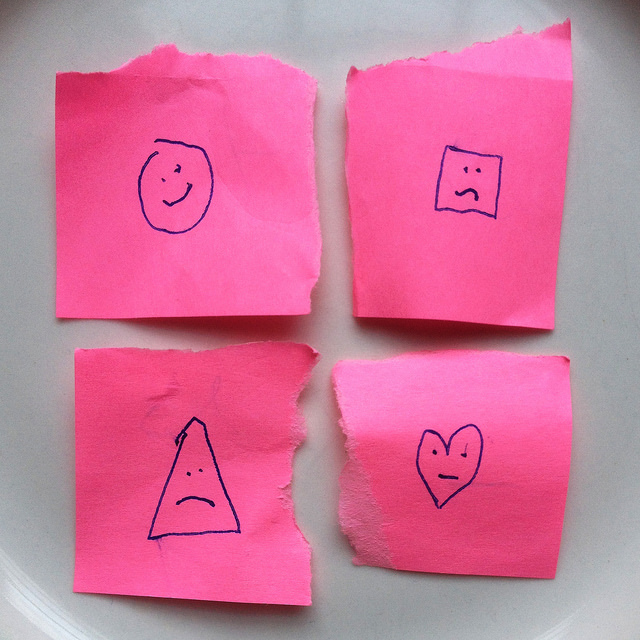During my first year of teaching, I dealt with a lot of challenging behaviors. In addition, I had kids who needed a lot of social and emotional support and were way behind in academics.
So I developed a simple solution that I’ve used every year since – no matter the grade level or make-up of students – it’s worked wonders.
Now it is the number one thing I could never teach without.
![The #1 Thing I Can't Teach Without [BlueMangoLLC.com]](http://www.bluemangollc.com/wp-content/uploads/2015/06/The-1-Thing-I-Cant-Teach-Without-BlueMangoLLC.com_.jpg) The #1 thing I cannot teach without
The #1 thing I cannot teach without
The concern box is a simple idea. It’s a box where students can write teachers confidential notes about anything that is bothering them – a friend excluded you on the playground, academic struggles or worries at home.
How does the concern box work?
In my classroom, students are usually allowed to write a concern at any point during the day. If something is bothering them so much they can’t focus on the lesson, I want them to write it down and get it out of their mind.
In a private area of the room, students use whatever writing skills they have (words, pictures, labels) to express their concern on a small piece of paper and sign their name (date if possible).
They then slip the note into the box where it can’t be seen by other students and the teacher can access it at a later time.

During a break time (lunch, recess, specials, after school) teachers go through the concerns and find a time later in the day, or soon the following day, to speak privately with the student.
The student then has the opportunity to describe their concern, decide whether the problem was solved and if not, work with the teacher to find a solution.
While sometimes the concern box brings up on-going issues that need to be addressed – perhaps with the counselor and parents (you’ll be thankful the child brought this issue to your attention before it became serious) – more often than not, nothing needs to be done.
This is the beauty of the concern box! Either the conflict is old news and the child has already moved on or the child just needed their feeling validated and is not looking for a solution.
Concern box rules
It’s important to establish firm rules when setting up the concern box. If with my most challenging students, after a few reminders they respected the right for everyone’s privacy.
The concern box then made students empowered and the concern box system became very effective.
- You can’t tell a person you are writing a concern about them
- Once a concern is written down, the problem is no longer discussed out loud
- Only a teacher is allowed to open the concern box
- You must write your name – and date if possible
- Writing a concern does NOT get you or someone else in trouble
- A teacher will talk to YOU first and if you want the teacher to talk with the other child or set up a meeting, she will do that
- You can write anything about school or home – it could just as simple as letting the teachers know you are feeling sad that day
While notes are confidential from other classmates, careful not to promise that anything will remain a secret.
Leaving playground problems on the playground
I found that the concern box was very helpful after recess. Kids are often over-excited during this time as they transition back into the classroom and emotions are running high if a negative interaction occurred outside.
It can be a hard time for classroom teachers to solve problem because often you are not out a recess duty, you don’t know the full story and just can’t solve the problem – all as precious learning time is ticking away.
Many times the problem was dealt with by a teacher on duty at recess, but the child has not accepted that yet or had time to settle down. However, you need the kids to get back to work.
Allow kids unlimited access to express their emotions
You’ll find that you have kids who spend a lot of time at the concern box, especially right after it’s introduced. That’s okay. While you want to make sure it’s not taking away from class time too much, these kids have a strong need to express themselves.
Don’t take that away from them.
Would you rather a child hones in her writing skills by thinking through her emotions a few times a day… or tattle, provoke other classmates and interrupt your lessons continuously throughout the day?
In addition, unfortunately some students carry a lot of anxiety to school with them – an ongoing conflict with their best friend, missing a parent who’s not at home or worried about their sick dog.
These students need an outlet for their strong emotions as well, which hold them back from fully participating in the classroom.
After all, anyone who’s worked in early childhood knows that emotional learning is just as (if not more) important as the ABC’s.
Reduce tattling while building emotional intelligence
I love the concern box for SO many reasons. It allows kids to work on some of the most important social, emotional and academic goals I have for students throughout the year.
In addition, it allows me to develop a relationship based on trust and respect with my students and helps me understand things about them as a learner and individual that I would have never known about them otherwise.
10 amazing benefits of setting up the Concern Box in your classroom
- Encourages independent writing & prewriting skills
- Significantly reduces tattling
- Reduces teacher intervention in peer conflicts – aka saves you time
- You can address concerns when you really have time to listen and focus on teaching the rest of the time
- Allows children who are shy or have difficulty with expressive language to share their concerns with you
- Brings concerns you never realized were there to your attention
- Gives kids a chance to confess
- Reduces social concerns so kids can focus on class
- Allows children to feel respected and heard
Some of the more surprising things that have come out of the concern box in my classroom are #5 and #6.
I had a sweet little boy one year (I’ll call him Thomas) who never complained about anything and worked hard in class. He seemed to really enjoy playing with another boy (I’ll call him Jason) on the playground.
However, one day Thomas wrote (drew) a concern that he no longer wanted to play with this Jason. I was shocked. They seemed to have a solid friendship and often had a lot of playdates.
When I sat down and talked with Thomas, he said that he was Jason’s servant and had to do everything that Jason said. This was huge! I don’t think this boy would have ever come to me and tell me this in person.
My co-teacher and I then worked hard to help these boys establish a positive healthy friendship the rest of the year.
#6 is just hilarious. “I drew on the blocks with the red marker.”
I usually never confronted these students, as they had already confessed to their crime but saved the note for my own amusement appreciating that their conscious finally got to them.
Make your concern box and get started!
Remember the concern box is not just for the classroom – try it at home! I often encourage kids who are struggling with anxiety about a social or academic issue to have a diary at home.
They can choose to share anything with their parents or keep it private – all that matters is that they are processing their emotions and having an outlet for these strong feelings.
Why I LOVE the concern box
Setting up a concern box in your classroom will enable you to learn so much about your students and develop a deeper, more trusting relationship with them.
And while, yes, it does provide a safe haven for any kid having some major issues at home or school to seek your help, mostly you will enjoy reading some really funny things kids have to say.
Image Credit: photos.de.tibo



